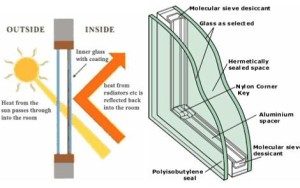
Selecting windows for custom homes or buildings is complicated. It’s among the biggest material investments in upfront costs. The choice includes durability, functionality, and energy use concerns. Of green building’s top 3 priorities, reducing monthly, energy use is the most important. Windows are a major part of efficient and durable building envelopes. Choosing quality windows increases a home’s value and reduces future maintenance problems.
 What is a Building Envelope?
What is a Building Envelope? ![]() The Blower Door Test.
The Blower Door Test.![]() Outdoor-Air Ventilation
Outdoor-Air Ventilation
Building envelopes are largely evaluated on air leakage, insulation and fenestration (windows).
This is an immense subject with varying opinions, strategies and individual situations. Part 1 summarizes choosing by brand, ergonomics and lists the common North American window styles for residential construction. Part 2 quantity and orientation explores average window area and the orientational relationships with the path of the sun. Part 3 materials covers window unit composition and future parts will attempt energy efficiency options and installation details.
Choosing Windows Based on Manufacturer Reputation and Warranty
Selection is often based on the advice and experience of the designers or builders. Reputation is more important than warranty. Be aware of differences between brand recognition and reputation. Problems with windows are common. Brand reputation includes the amount of window problems and how the company responds to those problems. We find GardenWeb’s window forum to be a good resource on reputations of various manufacturers. Vinyl and all-wood seem to have the widest range in quality among window units.
Warranty details are similar across the industry and manufacturers have leeway to avoid fixing problems legally. Good window companies acknowledge manufacturer defects and correct problems despite installation or warranty details. Choose quality products and reputation to avoid the warranty process altogether. With a reliably crafted window in hand, all you need to worry about is installation details. Builders Asheville NC and across the country have lots of room for improvement in typical window installations.
Choosing Window Suppliers
Window manufacturers usually use dealers, distributors or suppliers. The window supplier is just as important as the manufacturer. The supplier is responsible for quantity, sizing, pricing, delivery and a myriad of options and upgrades that come with a window package. If your builder or designer does not have a preferred vendor, interview several and don’t be afraid to ask for references. Visiting supplier showrooms is a good way to familiarize yourself with products hands-on.
Windows have long lead times and need selection early when building a home. Mistakes in the window order can be costly and results in numerous construction related headaches. Window problems and warranty claims are usually directed through the suppliers. Choose window suppliers based on window brand options and customer service.
Selecting Window Types From Least to Most Expensive (in upfront costs)
The first major distinction of window types are fixed/picture/non-operable versus operable. Take a close look at how many operable (open and close) windows are designed for, versus how many you actually need.
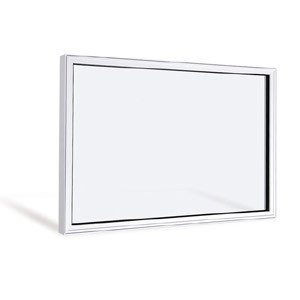
“Old Reliable”
People usually have more operable windows than needed. Fixed windows have the lowest upfront costs. They have less ongoing costs in terms of maintenance and energy use. Operable window hardware and weatherstripping needs to be maintained and replaced. Fixed windows have less problems from bulk water leaks but that’s usually more installation related. Fixed windows generally have less air-leakage which can heavily influence the blower door test results. They have less thermal bridging with their smaller frames which also provides more views and light.
Why So Many Operable Windows?
Ventilation is the main reason. When weather is good, its nice to open the windows. Usually one, egress-sized operable window per room provides plenty of ventilation. Big living areas call for more, but two or three is arguably enough, especially if on different exterior walls. The best natural window ventilation is achieved by creating cross flow through different rooms which depends on keeping interior doors open. This has a greater effect than more operable windows per room. This strategy is known as nighttime flushing with more detail at keeping homes cooler in the summer.
- While slightly increasing ventilation by adding more operable windows, the only measurable differences are increased energy, maintenance, and upfront costs with a reduction in light and outside views.
The Dreaded Double Hung Window (D)DH
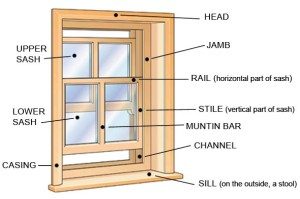
The double hung window is the most common operable window in this country. A variation is the Single Hung where the upper sash is fixed and only the lower sash moves up or down. Some model’s sashes tilt-in, to allow easier cleaning.
Double hungs have a place in many situations, mainly fitting into certain historical and architectural styles. They have an operation whose moving parts are arguably less prone to problems. My favorite thing about them in my older house is they are perfect for a box fan to help with nighttime flushing.
That’s where double hung good times end as they generally leak too much air from the beginning and get worse over time. The more trouble-free operation comes with weatherstripping concerns, as sliding parts wear out the leakier weatherstripping materials faster than other styles. The horizontal rail between the two sashes, contributes to more air and thermal leakage and its right in the middle of the window opening at eye level. Few things are more annoying than having the horizontal division in the middle of my view to the outside world. In general, double hungs are the least energy efficient while blocking more views and light.
Its possible one would not feel or see the difference in comfort or energy performance between double hung and other types which is truer for newer homes (fresher weatherstripping). Home design, orientation and glass tuning have the most measurable impact on energy efficiency for windows. Window units have listed values for airtightness, U-factor and Solar Heat Gain Coefficient SHGC which are better measurements of energy performance. The more quantity of operables and older the weatherstripping, the more likely a measurable difference in energy efficient performance.
Casement and Awning Windows


These windows fit more contemporary styles but its possible to have manufacturers add muntins to mimic a double hung or other traditional style. They are a common choice for those concerned with better views and energy efficiency. They usually have less thermal bridging and tighter sealing weatherstripping than sliders. A concern to be aware of is the outswinging sash gets more wet being left open in a rain.
An advantage of this aspect over other window types is that because they open out, they tend to collect and funnel more breeze when being used for ventilation. Casements offer 2x the ventilation and egress area than a similar sized double hung.
Tilt and Turn Windows
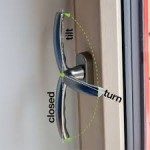
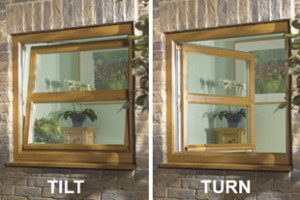
Tilt and Turn Windows are the predominant style in Europe. They are a joy to operate as a single, ergonomic lever handle, unlocks and tilts or swings the window open to the inside with ease. People love tilt and turns after living with them.
The concerns are upfront costs, interior furniture or traffic flow and blind operation. Exterior blind and shutter systems work more effectively than interior, so some see the inswing operation as a bonus. People use the tilt function more than the turn, and this provides enough ventilation, even with interior blinds down while offering more security.
Tilt and turn windows in North America are typically associated with luxury and high-performance homes. Considering the relative permanence and how much these windows impact daily life, they could be one of the best investments available for a high quality dwelling. There could be savings in the fixed versus operable window choices to balance the cost to upgrade.
Choosing Windows on Ergonomics
This is largely personal and the more you intend to operate them the more important the decision. By their nature, double hungs have a power struggle between ease of opening and weatherstripping seal integrity. There is usually a strong correlation between hardware quality, ergonomics, and durability in the form of less repair and maintenance. Certain manufacturer’s level of quality on lesser operable styles can be better than other companies more high-end attempts.
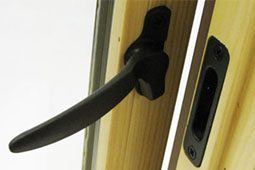

My personal list from best to worst of operable window ergonomics:
- Tilt and Turn Window
- Casement/Awning with Lever and Push Out
- Casement/Awning with Crank
- Double Hung or Horizontal Slider
.

In Choosing Windows Part 2 we take a step back exploring window quantities and orientations. Future parts explore materials, energy efficiency options, overhangs and installation details.
Brian Knight is owner of Springtime Builders Asheville NC, specializing in building science craftsmanship.

